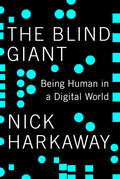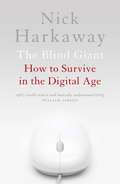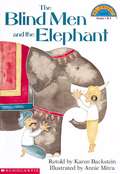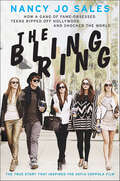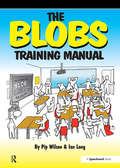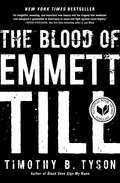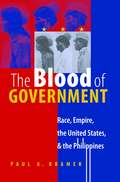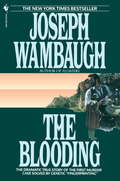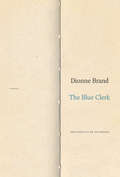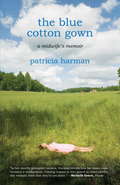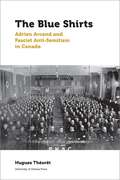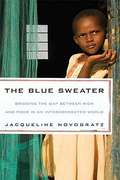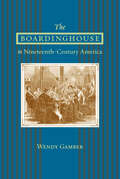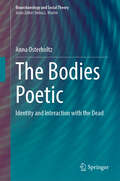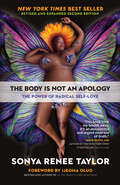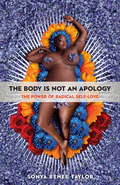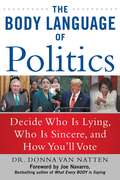- Table View
- List View
The Blind Giant
by Nick HarkawayNick Harkaway, author of Angelmaker, presents a rousing and energizing look at how we can meaningfully and constructively engage with technology--creating an essential handbook for anyone trying to be human in a digital age. Some say our devices will lead us to ruin: isolating us from our neighbors, warping communication, delivering an unregulated flood of information that will destroy our humanity. Some say they will be our salvation: enabling global communication and social engagement, putting all the world's facts at our fingertips, and erasing the barriers that divide us, bringing out the best qualities of humanity. In The Blind Giant, novelist and blogger Nick Harkaway takes us on a lucid, insightful and personal tour of how we live our lives in our technology-obsessed culture. A self-described "missing link" between the pre-Internet generation and the "digital natives" who have grown up with technology, Nick is an enthusiastic guide to digital culture who weaves together examples from literature, psychology, neurology, sociology, history, and his own life while exploring the hazards and joys of the human-machine relationship. In the final analysis, whether we meaningfully engage with the machines we have created, or risk living in a world which is designed to serve computers and corporations rather than people, this book is a must-read for anyone concerned with our digital future.
The Blind Giant: How to Survive in the Digital Age
by Nick HarkawayThe digital age. An age of isolation, warped communication, disintegrating community. Where unfiltered and unregulated information pours relentlessly into our lives, destroying what it means to be human. Or an age of marvels. Where there is a world of wonder at our fingertips. Where we can communicate across the globe, learn in the blink of an eye, pull down the barriers that divide us and move forward together. Whatever your reaction to technological culture, the speed with which our world is changing is both mesmerising and challenging. In The Blind Giant, novelist and tech blogger Nick Harkaway draws together fascinating and disparate ideas to challenge the notion that digital culture is the source of all our modern ills, while at the same time showing where the dangers are real and suggesting how they can be combated. Ultimately, the choice is ours: engage with the machines that we have created, or risk creating a world which is designed for corporations and computers rather than people. This is an essential handbook for everyone trying to be human in a digital age.
The Blind Giant: How to Survive in the Digital Age
by Nick HarkawayThe digital age. An age of isolation, warped communication, disintegrating community. Where unfiltered and unregulated information pours relentlessly into our lives, destroying what it means to be human. Or an age of marvels. Where there is a world of wonder at our fingertips. Where we can communicate across the globe, learn in the blink of an eye, pull down the barriers that divide us and move forward together. Whatever your reaction to technological culture, the speed with which our world is changing is both mesmerising and challenging. In The Blind Giant, novelist and tech blogger Nick Harkaway draws together fascinating and disparate ideas to challenge the notion that digital culture is the source of all our modern ills, while at the same time showing where the dangers are real and suggesting how they can be combated. Ultimately, the choice is ours: engage with the machines that we have created, or risk creating a world which is designed for corporations and computers rather than people. This is an essential handbook for everyone trying to be human in a digital age.
The Blind Man: A Phantasmography (Thinking from Elsewhere)
by Robert DesjarlaisThe Blind Man: A Phantasmography examines the complicated forces of perception, imagination, and phantasms of encounter in the contemporary world. In considering photographs he took while he was traveling in France, anthropologist and writer Robert Desjarlais reflects on a few pictures that show the features of a man, apparently blind, who begs for money at a religious site in Paris, frequented by tourists. In perceiving this stranger and the images his appearance projects, he begins to imagine what this man’s life is like and how he perceives the world around him.Written in journal form, the book narrates Desjarlais’s pursuit of the man portrayed in the photographs. He travels to Paris and tries to meet with him. Eventually, Desjarlais becomes unsure as to what he sees, hears, or remembers. Through these interpretive dilemmas he senses the complexities of perception, where all is multiple, shifting, spectral, a surge of phantasms in which the actual and the imagined are endlessly blurred and intertwined. His mind shifts from thinking about photographs and images to being fixed on the visceral force of apparitions. His own vision is affected in a troubling way.Composed of an intricate weave of text and image, The Blind Man attends to pressing issues in contemporary life: the fraught dimensions of photographic capture; encounters with others and alterity; the politics of looking; media images of violence and abjection; and the nature of fantasy and imaginative construal. Through a wide-ranging inquiry into histories of imagination, Desjarlais inscribes the need for a “phantasmography”—a writing of phantasms, a graphic inscription of the flows and currents of fantasy and fabulation.
The Blind Men and the Elephant
by Lillian F. QuigleyIn this Indian Folk Tale six blind men learn how to share their impressions to make a whole.
The Blind in School and Society: A Psychological Study
by Thomas D. CutsforthThe purpose of this book is to help acquaint the seeing with the blind and the blind with themselves.
The Bling Ring: How a Gang of Fame-Obsessed Teens Ripped Off Hollywood and Shocked the World
by Nancy Jo SalesThe inspiration for the Sofia Coppola film. The true story of the privileged teenagers who stole millions of dollars worth of valuables from celebrities.With a list of victims that reads like a “Who’s Who” of young Hollywood, including Lindsay Lohan, Orlando Bloom, Paris Hilton, and Rachel Bilson, The Bling Ring is the stuff of writers’ imaginations—with one exception—it’s a true story.The media asked: Why would a group of kids who already had designer clothes, money, cars, and status take such risks? Award-winning journalist Nancy Jo Sales found the answer: They did it because they could. And because it was easy.“A great piece of crime reportage,” The Bling Ring is a shocking look at the seedy world of the real young Hollywood (The New York Observer).“For a satire on America’s modern day celebrity culture, The Bling Ring is hard to beat.” —The Guardian“Sales [is] a superlative reporter.” —People“Absolutely terrific.” —The Awl“Brilliant.” —Grazia Daily
The Blobs Training Manual: A Speechmark Practical Training Manual
by Pip Wilson Ian LongDiscover the full potential of the Blobs! Eagerly awaited, this comprehensive resource book for understanding and using Blobs provides: a fantastic insight into Blobs and Blob Trees, their development and the theory behind them; clear instructions on how Blobs can be used to discuss a wide variety of important issues, emotions or feelings; session ideas and activities for working with groups and individuals of all ages; questions to use with the Blobs; and, what not to do when using Blobs! Ideal for anyone new to the Blobs resources, this manual will also provide background information and additional ideas for those familiar with this engaging series.
The Blood of Emmett Till
by Timothy B. TysonThis extraordinary New York Times bestseller reexamines a pivotal event of the civil rights movement—the 1955 lynching of Emmett Till—&“and demands that we do the one vital thing we aren&’t often enough asked to do with history: learn from it&” (The Atlantic). * A New York Times Notable Book * A Washington Post Notable Book * Longlisted for the National Book Award * Winner of the Robert F. Kennedy Book Award *An NPR, Los Angeles Times, and Atlanta Journal-Constitution Best Book of the Year *In 1955, white men in the Mississippi Delta lynched a fourteen-year-old from Chicago named Emmett Till. His murder was part of a wave of white terrorism in the wake of the 1954 Supreme Court decision that declared public school segregation unconstitutional. Only weeks later, Rosa Parks thought about young Emmett as she refused to move to the back of a city bus in Montgomery, Alabama. Five years later, Black students who called themselves &“the Emmett Till generation&” launched sit-in campaigns that turned the struggle for civil rights into a mass movement. Till&’s lynching became the most notorious hate crime in American history. But what actually happened to Emmett Till—not the icon of injustice, but the flesh-and-blood boy? Part detective story, part political history, The Blood of Emmett Till &“unfolds like a movie&” (The Atlanta Journal-Constitution), drawing on a wealth of new evidence, including a shocking admission of Till&’s innocence from the woman in whose name he was killed. &“Jolting and powerful&” (The Washington Post), the book &“provides fresh insight into the way race has informed and deformed our democratic institutions&” (Diane McWhorter, Pulitzer Prize–winning author of Carry Me Home) and &“calls us to the cause of justice today&” (Rev. Dr. William J. Barber, II, president of the North Carolina NAACP).
The Blood of Government
by Paul A. KramerIn 1899 the United States, having announced its arrival as a world power during the Spanish-Cuban-American War, inaugurated a brutal war of imperial conquest against the Philippine Republic. Over the next five decades, U.S. imperialists justified their colonial empire by crafting novel racial ideologies adapted to new realities of collaboration and anticolonial resistance. In this pathbreaking, transnational study, Paul A. Kramer reveals how racial politics served U.S. empire, and how empire-building in turn transformed ideas of race and nation in both the United States and the Philippines.Kramer argues that Philippine-American colonial history was characterized by struggles over sovereignty and recognition. In the wake of a racial-exterminist war, U.S. colonialists, in dialogue with Filipino elites, divided the Philippine population into "civilized" Christians and "savage" animists and Muslims. The former were subjected to a calibrated colonialism that gradually extended them self-government as they demonstrated their "capacities." The latter were governed first by Americans, then by Christian Filipinos who had proven themselves worthy of shouldering the "white man's burden." Ultimately, however, this racial vision of imperial nation-building collided with U.S. nativist efforts to insulate the United States from its colonies, even at the cost of Philippine independence. Kramer provides an innovative account of the global transformations of race and the centrality of empire to twentieth-century U.S. and Philippine histories.
The Blooding
by Joseph WambaughFor the first time, Joseph Wambaugh turns his attention outside the United States to deal with two murders in neighboring English Midlands villages-ancient villages that still have whitewashed Tudor cottages, pavements too narrow for passing baby prams, streets barely wide enough for two cars, and churches or pubs as the sites of community life. What intrigues the master of true-crime writing is that out of the sleepy setting grew a landmark case: the first murders solved by genetic fingerprinting. The victims of the terrifying rape-murders -two fifteen-year-old girls who do not know each other-have in common one fatal mistake: they choose to walk village footpaths bordering the lands of a psychiatric hospital. Forever after, the names Ten Pound Lane and The Black Pad will evoke fear and dread. The murders occur three years apart, and during all those years the members of the Leicestershire constabulary never give up their search. The local newspapers cooperate by keeping the cases alive. And the families of the victims try to cope with the chaos of their existence.
The Blooding
by Joseph WambaughFifteen-year-old Lynda Mann's savagely raped and strangled body is found along a shady footpath near the English village of Narborough. Though a massive 150-man dragnet is launched, the case remains unsolved. Three years later the killer strikes again, raping and strangling teenager Dawn Ashforth only a stone's throw from where Lynda was so brutally murdered. But it will take four years, a scientific breakthrough, the largest manhunt in British crime annals, and the blooding of more than four thousand men before the real killer is found.
The Blue Clerk: Ars Poetica in 59 Versos
by Dionne Brand<P>On a lonely wharf a clerk in an ink-blue coat inspects bales and bales of paper that hold a poet's accumulated left-hand pages—the unwritten, the withheld, the unexpressed, the withdrawn, the restrained, the word-shard. <P>In The Blue Clerk renowned poet Dionne Brand stages a conversation and an argument between the poet and the Blue Clerk, who is the keeper of the poet's pages. In their dialogues—which take shape as a series of haunting prose poems—the poet and the clerk invoke a host of writers, philosophers, and artists, from Jacob Lawrence, Lola Kiepja, and Walter Benjamin to John Coltrane, Josephine Turalba, and Jorge Luis Borges. <P>Through these essay poems, Brand explores memory, language, culture, and time while intimately interrogating the act and difficulty of writing, the relationship between the poet and the world, and the link between author and art. Inviting the reader to engage with the resonant meanings of the withheld, Brand offers a profound and moving philosophy of writing and a wide-ranging analysis of the present world.
The Blue Cotton Gown
by Patricia HarmanA 2008 Indie Next PickDespite nurse-midwife Patsy Harman's own financial and personal medical trials, including her private battle with uterine cancer, she devotes herself to her patients' well-being in all aspects of their lives. They, in turn, tell her intimate stories both heartbreaking and uplifting.
The Blue Shirts: Adrien Arcand and Fascist Anti-Semitism in Canada (Canadian Studies)
by Hugues ThéorêtWhile Adolf Hitler was seizing power in Germany, Adrien Arcand was laying the foundations in Quebec for his Parti national social chrétien. The Blue Shirts, as its members were called, wore a military uniform and prominently displayed the swastika. Arcand saw Jewish conspiracy wherever he turned and his views resonated with his followers who, like him, sought a scapegoat for all the ills eroding society. Even after his imprisonment during the Second World War, the fanatical Adrien Arcand continued his correspondence with those on the frontlines of anti-semitism. Until his death in 1967, he pursued his campaign of propaganda against communists and Jews. Hugues Théorêt describes a dark period in Quebec’s ideological history using an objective approach and careful, rigorous research in this book, which won the 2015 Canada Prize (Federation for the Humanities and Social Sciences).
The Blue Sweater: Bridging the Gap between Rich and Poor in an Interconnected World
by Jacqueline NovogratzThe Blue Sweater is the inspiring story of a woman who left a career in international banking to spend her life on a quest to understand global poverty and find powerful new ways of tackling it.
The Bluestockings: A History of the First Women's Movement
by Susannah GibsonAn illuminating group portrait of the eighteenth-century women who dared to imagine an active life for themselves in both mind and spirit. In England in the 1700s, a woman who was an intellectual, spoke out, or wrote professionally was considered unnatural. After all, as the wisdom of the era dictated, a clever woman—if there were such a thing—would never make a good wife. But a circle of women called the Bluestockings did something extraordinary: coming together in glittering salons to discuss and debate as intellectual equals with men, they fought for women to be educated and to have a public role in society. In this intimate and revelatory history, Susannah Gibson delves into the lives of these pioneering women. Elizabeth Montagu established one of the most famous salons of the Bluestocking movement, with everyone from royalty to revolutionaries clamoring for an invitation to attend. Her younger sister, Sarah Scott, imagined a female-run society and created a women’s commune. Meanwhile, Hester Thrale, who also had a salon, saved her husband’s brewery from bankruptcy and, after being widowed, married a man she loved—Italian, Catholic, and not of her social class. Other women made a name for themselves through their publications, including Catharine Macaulay, author of an eight-volume history of England, and Frances Burney, author of the audacious novel Evelina. In elegant prose, Gibson reveals the close and complicated relationships between these women, how they supported and admired each other, and how they sometimes judged and exploited one another. Some rebelled quietly, while others defied propriety with adventurous and scandalous lives. With moving stories and keen insight, The Bluestockings uncovers how a group of remarkable women slowly built up an eviscerating critique of their male-dominated world that society was not yet ready to hear.
The Boardinghouse in Nineteenth-Century America
by Wendy GamberIn nineteenth-century America, the bourgeois home epitomized family, morality, and virtue. But this era also witnessed massive urban growth and the acceptance of the market as the overarching model for economic relations. A rapidly changing environment bred the antithesis of "home": the urban boardinghouse. In this groundbreaking study, Wendy Gamber explores the experiences of the numerous people—old and young, married and single, rich and poor—who made boardinghouses their homes.Gamber contends that the very existence of the boardinghouse helped create the domestic ideal of the single family home. Where the home was private, the boardinghouse theoretically was public. If homes nurtured virtue, boardinghouses supposedly bred vice. Focusing on the larger cultural meanings and the commonplace realities of women’s work, she examines how the houses were run, the landladies who operated them, and the day-to-day considerations of food, cleanliness, and petty crime. From ravenous bedbugs to penny-pinching landladies, from disreputable housemates to "boarder's beef," Gamber illuminates the annoyances—and the satisfactions—of nineteenth-century boarding life.
The Boat People: An 'Age' Investigation
by Bruce Grant"The Boat People" drew on the reports of foreign correspondents of the Australian newspaper, the "Age", which undertook this special international investigation into the events behind the refugee crisis.
The Bodies Poetic: Identity and Interaction with the Dead (Bioarchaeology and Social Theory)
by Anna OsterholtzThis book examines the intricate relationships between the living and the dead, revealing how these interactions shape group identities and facilitate ongoing negotiations of self and community. Beginning with a rich exploration of bioarchaeological theories, this volume introduces an enriched Poetics model, which deepens our understanding of not just skeletal remains, but the broader contexts that imbue bodies with social significance and how those bodies in turn can produce socially significant changes. By emphasizing the roles of performance and ritual, the work illustrates how the dead serve as powerful tools in the creation and maintenance of social structures. Through compelling case studies of ancient and modern mortuary practices, it highlights the changing meanings of the body across different historical and cultural landscapes. The volume demonstrates that while our interpretations may shift, the body remains a profound source of meaning and identity. By analyzing patterns of modification and representation, this book provides invaluable insights into social change and how group identity is forged.
The Bodies of Others: Drag Dances and Their Afterlives (Triangulations: Lesbian/Gay/Queer Theater/Drama/Performance)
by Selby Wynn SchwartzThe Bodies of Others explores the politics of gender in motion. From drag ballerinas to faux queens, and from butoh divas to the club mothers of modern dance, the book delves into four decades of drag dances on American stages. Drag dances take us beyond glittery one-liners and into the spaces between gender norms. In these backstage histories, dancers give their bodies over to other selves, opening up the category of realness. The book maps out a drag politics of embodiment, connecting drag dances to queer hope, memory, and mourning. There are aging étoiles, midnight shows, mystical séances, and all of the dust and velvet of divas in their dressing-rooms. But these forty years of drag dances are also a cultural history, including Mark Morris dancing the death of Dido in the shadow of AIDS, and the swans of Les Ballets Trockadero de Monte Carlo sketching an antiracist vision for ballet. Drawing on queer theory, dance history, and the embodied practices of dancers themselves, The Bodies of Others examines the ways in which drag dances undertake the work of a shared queer and trans politics.
The Body Is Not an Apology, Second Edition: The Power of Radical Self-Love
by Sonya Renee TaylorNew York Times bestseller! "To build a world that works for everyone, we must first make the radical decision to love every facet of ourselves. . . . 'The body is not an apology' is the mantra we should all embrace."—Kimberlé Crenshaw, legal scholar and founder and Executive Director, African American Policy ForumHumans are a varied and divergent bunch with all manner of beliefs, morals, and bodies. Systems of oppression thrive off our inability to make peace with difference and injure the relationship we have with our own bodies.The Body Is Not an Apology offers radical self-love as the balm to heal the wounds inflicted by these violent systems. World-renowned activist and poet Sonya Renee Taylor invites us to reconnect with the radical origins of our minds and bodies and celebrate our collective, enduring strength. As we awaken to our own indoctrinated body shame, we feel inspired to awaken others and to interrupt the systems that perpetuate body shame and oppression against all bodies. When we act from this truth on a global scale, we usher in the transformative opportunity of radical self-love, which is the opportunity for a more just, equitable, and compassionate world—for us all.This second edition includes stories from Taylor's travels around the world combating body terrorism and shines a light on the path toward liberation guided by love. In a brand new final chapter, she offers specific tools, actions, and resources for confronting racism, sexism, ableism, homophobia, and transphobia. And she provides a case study showing how radical self-love not only dismantles shame and self-loathing in us but has the power to dismantle entire systems of injustice. Together with the accompanying workbook, Your Body Is Not an Apology, Taylor brings the practice of radical self-love to life.
The Body Is Not an Apology: The Power of Radical Self-Love
by Sonya Renee TaylorThe Body Is Not an ApologyThe Power of Radical Self-LoveAgainst a global backdrop of war, social upheaval, and personal despair, there is a growing sense of urgency to challenge the systems of oppression that dehumanize bodies and strip us of our shared humanity. Rather than feel helpless in the face of oppression, world-renowned activist, performance poet, and author Sonya Renee Taylor teaches us how to turn to the power of radical self-love in her new book, The Body Is Not an Apology. Radical self-love is the guiding framework that transforms the learned self-hatred of our bodies and the prejudices we have about other people's bodies into a vision of compassion, equity, and justice. In a revolutionary departure from the corporate self-help and body-positivity movement, Taylor forges the inextricable bond between radical self-love and social justice. The first step is recognizing that we have all been indoctrinated into a system of body shame that profits off of our self-hatred. When we ask ourselves, “Who benefits from our collective shame?” we can begin to make the distinction between the messages we are receiving about our bodies or other bodies and the truth. This book moves us beyond our all-too-often hidden lives, where we are easily encouraged to forget that we are whole humans having whole human experiences in our bodies alongside others. Radical self-love encourages us to embark on a personal journey of transformation with thoughtful reflection on the origins of our minds and bodies as a source of strength. In doing this, we not only learn to reject negative messages about ourselves but begin to thwart the very power structures that uphold them. Systems of oppression thrive off of our inability to make peace with bodies and difference. Radical self-love not only dismantles shame and self-loathing in us but has the power to dismantle global systems of injustice—because when we make peace with our bodies, only then do we have the capacity to truly make peace with the bodies of others.
The Body Language Handbook: How to Read Everyone's Hidden Thoughts and Intentions
by Gregory Hartley Maryann KarinchIn "The Body Language Handbook", the authors use candid photos of real people in stress-free situations, then juxtapose them against others showing the same people responding to different kinds of stimulus to illustrate the power of body language. By going step-by-step from the holistic to the detailed, you'll quickly discover when body language indicates something significant, and when an itch is just an itch.
The Body Language of Politics: Decide Who is Lying, Who is Sincere, and How You'll Vote
by Dr. Donna Van NattenLearn how to spot the lies and deceptions of our politicians in action. You can&’t turn on the television, check your phone, or scroll through social media without being besieged with political headlines and the "Who&’s Who" of today&’s news. With so much spoon-fed to us by the media, fake news, and from politicians themselves, it&’s time to take the reins and control what you see, feel, and know so you can make informed political choices in our hot, political environment. In The Body Language of Politics, body language expert Dr. Donna Van Natten provides you with the tools and resources that you need to analyze movements of today's most notable politicians. She looks at some of the looming figures in our political landscape—Donald Trump, Hillary Clinton, Nancy Pelosi, Mitch McConnell, Chuck Schumer, and Alexandria Ocasio-Cortez, among others—and analyzes their physical behaviors, breaking down the lies and deceptions embedded in their everyday movements. Further, Dr. Van Natten challenges you to understand your own emotional biases towards certain politicians, and examine how that may skew your read of their body language. Finally, she confronts the gendered stereotypes that we often apply to our nation's leaders, examining how those labels play into our opinions of politicians. Clear, concise, and filled with expert knowledge, The Body Language of Politics will help you make an informed decision at the voting booth.
